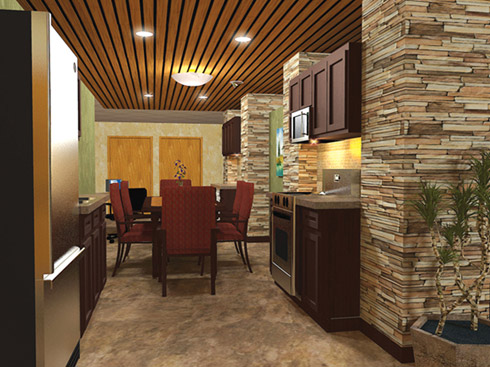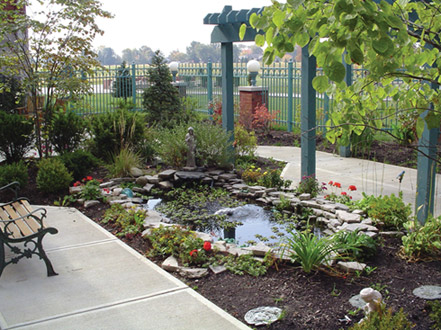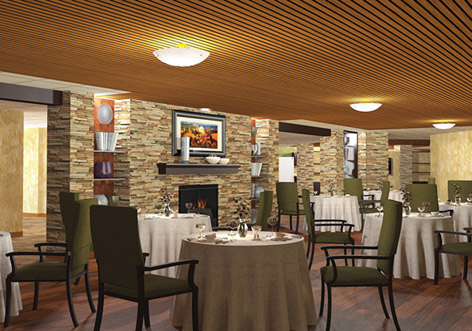Dynamic Designs In Long Term Care
Experts offer advice on seniors housing design that improves quality of life for residents and still meets the bottom line.
Christopher Ewald, Lynne Gochenour, and Robert Siebenaller
10/1/2010
The renovation or construction of a long term or post-acute care facility begins with a process that will engage administrators, finance officers, owners, operators, and the design team in a dialogue that will shape the facility and how it operates. How that dialogue unfolds will determine the success, or lack

thereof, for years to come.
Selecting a design team that understands the process is essential.
Identify Mission, Ideals, Values
Discussions regarding new construction, expansion, or renovation of a nursing facility or assisted living residence must examine the mission and values of the provider.
With a focused reflection and analysis of how the mission and vision should be reflected in the desired environment, these discussions can lead to projects that serve their residents particularly well.
Engaging, passionate, and reflective conversations articulate a community’s ideals and values for quality of care and quality of life. This process maximizes the potential of design to create a long term care facility that enhances quality of care, while also meeting the provider’s critical business objectives.
To facilitate a reflective conversation, begin with a clear, broad discussion of mission, vision, and ideals. Open-ended questions should be posed rather than statements that contain implied design solutions. To gain the broadest possible perspective, these sessions should involve the organization’s administrative leaders, financial officers, medical directors, nursing staff, support and facilities staff, and potentially residents and family members.

As the team grapples with mission and value questions, two other sets of drivers can be overlaid in the discussion: quality of life and price point. When the provider’s mission is viewed through the lens of quality and price, the design team can begin to create spatial images of the facility.
This process, which is continual and repeated several times throughout the design process, allows a design to evolve that can be tested against the criteria of mission, quality, and price.
A Day In The Life Of A Community
When design teams examine practices in long term and post-acute care, they should seek an appropriate understanding of the regional community—its values, its ideals, and its way of life. Participants should be encouraged to reflect on these issues during interactive conversations.
This is the time to explore what participants or their community believe is appropriate or not, desirable or unwanted, relevant or unimportant. Participants should be probed about why they feel the way they do.
Design teams gain insight when they ask participants to imagine and describe key events in a resident’s typical day, such as waking, bathing, dining, sleeping, socializing, receiving visitors, and participating in other activities. This type of probing enables the design team to envision the facility from the resident and employee point of view.
Over time, the discussion leads to an in-depth understanding of the facility’s current approach, as well as desired areas of improvement. At this point, the design team is ready to develop a building program that will in turn be the basis for schematic design.
Administrators and staff should be aware that when the design team presents an initial design, it was created by translating words into visual concepts. It will therefore represent a first level of understanding for which more interaction and discussion are necessary.
Through the continued work of the project team, the design is refined; the design team will test its interpretation of the vision and

adjust the design accordingly. When all participants fully contribute to this process, their input maximizes the possibilities.
Beginning to unfold is a facility that reflects the community’s way of life, enhances quality of care for residents, and meets the provider’s financial objectives.
A Win-Win For All
Utilizing a continual design approach and an exploratory process maximizes the design team’s potential to create a facility that improves quality of care for residents.
In the most successful cases, administrators and staff share their passion and creativity in an open-minded approach. Beginning the conversation with a focus on the best care for residents and not solely how the facility can be constructed for less can yield unanticipated benefits.
What’s more, identifying features that are highly desirable will inspire design innovations that can enhance staff recruitment, retention, and overall satisfaction.
Christopher Ewald, AIA, NCARB, LEED AP, is a retired vice president at SSOE Group, an international engineering, procurement, and construction management firm. He can be reached at cewald@SSOE.com. Lynne Gochenour, IIDA, AAHID, LEED AP, senior interior designer and senior associate at SSOE Group, can be reached (419) 255-3830 or lgochenour@SSOE.com. Robert Siebenaller, AIA, NCARB, LEED AP BD+C, serves as a division manager, project manager, and senior associate at SSOE Group. He can be reached at (419) 255-3830 or rsiebenaller@SSOE.com.